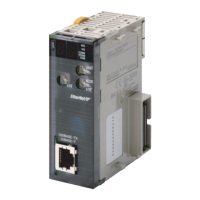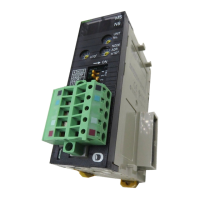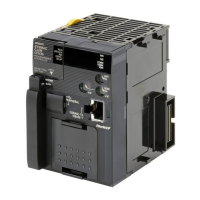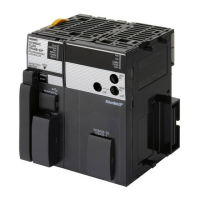
Do you have a question about the Omron CJ1W-EIP21 and is the answer not in the manual?
| Model | CJ1W-EIP21 |
|---|---|
| Type | Ethernet/IP Unit |
| Category | Controller |
| Communication Protocol | Ethernet/IP |
| Number of Connections | 32 |
| Number of Nodes | 64 |
| Transmission Speed | 10/100 Mbps |
| Connector | RJ45 |
| Number of Ports | 1 |
| Port Type | Ethernet |
| Operating Temperature | 0 to 55 °C |
| Weight | 200 g |
| Compatibility | CJ1 series PLC |
| Power Supply | 5 VDC |
Highlights critical safety information that, if not heeded, could result in death or serious injury.
Provides precautions that, if not heeded, may result in minor injury or property damage.
Provides an overview of the EtherNet/IP Unit, its features, and system configuration.
Details the steps and components required for setting up an EtherNet/IP network and installing the unit.
Explains how to map device variables for CJ-series Units to the EtherNet/IP Unit for data exchange with the CPU Unit.
Covers the concepts of IP addressing, subnet masks, CIDR, and methods for setting IP addresses for the EtherNet/IP Unit.
Guides users on configuring the EtherNet/IP Unit using Sysmac Studio, including TCP/IP, Link, FTP, SNTP, SNMP, and Status Area settings.
Describes methods for testing network communications, primarily using the PING command.
Explains the functionality, specifications, and procedures for setting up and using tag data links for cyclic data exchange.
Details the CIP message communications service, including instructions, route paths, and objects sent to the EtherNet/IP Unit.
Explains how to use the built-in FTP server for file transfers to and from the SD Memory Card in the CPU Unit.
Provides guidance on checking status, interpreting indicators, error logs, and common troubleshooting steps for the EtherNet/IP Unit.
Provides essential guidelines for safe usage, covering disassembly, mounting, installation, wiring, and power supply design.
Details precautions for correct operation, including storage, mounting, wiring, error processing, and motion control.
Warns against touching terminals or internal parts when power is supplied or recently turned off due to electric shock risk.
Emphasizes implementing external safety measures in circuits to ensure system safety during abnormalities or incorrect operation.
Warns against touching the unit when power is supplied or immediately after power off to prevent burn injury.
Advises ensuring terminal screws and connector screws are tightened to specified torque to prevent fire or malfunction.
Details how to configure unit number and node address settings using the rotary switches on the unit's front panel.
Provides instructions on physically installing the EtherNet/IP Unit into an NJ-series CPU Rack or CJ-series Expansion Rack.
Explains how data is exchanged between the CPU Unit and the EtherNet/IP Unit, detailing data flow and types.
Describes the device variables used for software switches, status, and setup data for the CJ-series Unit when used with EtherNet/IP.
Details methods for setting the IP address, including user-specified addresses and obtaining addresses via BOOTP server.
Covers updating and restoring default unit settings for the EtherNet/IP Unit via Sysmac Studio.
Explains how to configure TCP/IP settings, including IP address, subnet mask, default gateway, and DNS settings.
Details how the EtherNet/IP Unit responds to PING commands sent by other nodes or host computers.
Explains the concept of tag data links for cyclic data exchange, including originator, target, and connection information.
Describes how tag data links enable cyclic data exchange between devices and how variables are assigned to tags.
Explains how tag data links are automatically started and how they can be manually started or stopped via the user program or Network Configurator.
Provides a step-by-step guide to setting up tag data links using the Network Configurator.
Details the procedure for launching the Network Configurator application from the Windows Start Menu.
Outlines the steps for creating network configurations, tags, tag sets, and connections for tag data links.
Explains how to register devices, such as EtherNet/IP Units, in the network configuration pane.
Guides users through creating tags and tag sets using the Network Configurator's device parameter editing function and importing variables from Sysmac Studio.
Details how to set up connection information, including target device, connection type, RPI, and connection name.
Provides instructions for establishing an online connection between the Network Configurator and the EtherNet/IP network via Ethernet or USB.
Explains the procedure for downloading tag data link parameters, including tag set and connection settings, to the EtherNet/IP Units.
Describes how to upload tag data link parameters from EtherNet/IP Units in the network to the Network Configurator.
Explains how to compare network configuration files with device parameters to verify tag data links and check for inconsistencies.
Details methods for automatically starting tag data links and manually starting or stopping them via the user program or Network Configurator.
Provides guidance on how to implement ladder logic for tag data links, including conditions for normal operation and error detection.
Details the conditions required to enable tag data links and how to use PLC status for input conditions.
Details the available CIP communications instructions (CIPUCMMRead, CIPUCMMWrite, CIPUCMMSend) for reading, writing, and sending commands.
Outlines the procedure for using the FTP server function and lists the required settings in Sysmac Studio.
Lists and describes the FTP commands that can be sent from the host computer to the EtherNet/IP Unit's FTP server.
Outlines the steps required to configure and use the automatic clock adjustment function via Sysmac Studio.
Lists the specific settings required in Sysmac Studio for automatic clock adjustment, including SNTP server details.
Outlines the steps for configuring and using the SNMP agent, including basic settings and recognition configurations.
Lists the specific settings required in Sysmac Studio for the SNMP agent and SNMP trap functions.
Details the Requested Packet Interval (RPI) settings and heartbeat frame transmission periods that govern data link communication.
Provides guidance on managing network bandwidth and communications load by adjusting settings like buffer capacity and QoS.
Details three methods for changing the Packet Interval (RPI) settings to adjust capacity usage and improve communications performance.
Guides on using the Network Configurator's Device Monitor function to check the status of devices and connections.
Details how to interpret LED indicators (MS, NS, COMM, 100M, 10M) and the 7-segment display for identifying and troubleshooting errors.
Lists common errors related to CPU Unit data exchange, software switches, memory access, and network issues, along with their causes and countermeasures.
Offers general troubleshooting advice for common issues, such as CPU Unit ERR indicator status and Ethernet problems.
Helps troubleshoot issues where tag data links do not start, indicated by specific LED statuses and 7-segment display codes.











